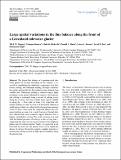Files in this item
Large spatial variations in the flux balance along the front of a Greenland tidewater glacier
Item metadata
| dc.contributor.author | Wagner, Till J.W. | |
| dc.contributor.author | Straneo, Fiamma | |
| dc.contributor.author | Richards, Clark G. | |
| dc.contributor.author | Slater, Donald A. | |
| dc.contributor.author | Stevens, Laura A. | |
| dc.contributor.author | Das, Sarah B. | |
| dc.contributor.author | Singh, Hanumant | |
| dc.date.accessioned | 2020-03-13T10:30:04Z | |
| dc.date.available | 2020-03-13T10:30:04Z | |
| dc.date.issued | 2019-03-15 | |
| dc.identifier | 266866307 | |
| dc.identifier | 2c442e34-a355-4291-a6b9-37abbf2cb3bf | |
| dc.identifier | 85063062669 | |
| dc.identifier.citation | Wagner , T J W , Straneo , F , Richards , C G , Slater , D A , Stevens , L A , Das , S B & Singh , H 2019 , ' Large spatial variations in the flux balance along the front of a Greenland tidewater glacier ' , Cryosphere , vol. 13 , no. 3 , pp. 911-925 . https://doi.org/10.5194/tc-13-911-2019 | en |
| dc.identifier.issn | 1994-0416 | |
| dc.identifier.other | ORCID: /0000-0001-8394-6149/work/70619150 | |
| dc.identifier.uri | https://hdl.handle.net/10023/19647 | |
| dc.description | We acknowledge support from the Woods Hole Oceanographic Institution Ocean and Climate Change Institute Arctic Research Initiative, and NSF OPP-1418256 and OPP-1743693, to Fiamma Straneo and Sarah B. Das. Till J. W. Wagner was further supported by NSF OPP award 1744835. Geospatial support for this work was provided by the Polar Geospatial Center under NSF OPP awards 1043681 and 1559691. DEMs provided by the Polar Geospatial Center under NSF OPP awards 1043681, 1559691, and 1542736. Donald A. Slater acknowledges the support of Scottish Alliance for Geoscience, Environment and Society early-career research exchange funding. | en |
| dc.description.abstract | The frontal flux balance of a medium-sized tidewater glacier in western Greenland in the summer is assessed by quantifying the individual components (ice flux, retreat, calving, and submarine melting) through a combination of data and models. Ice flux and retreat are obtained from satellite data. Submarine melting is derived using a high-resolution ocean model informed by near-ice observations, and calving is estimated using a record of calving events along the ice front. All terms exhibit large spatial variability along the ∼ 5 km wide ice front. It is found that submarine melting accounts for much of the frontal ablation in small regions where two subglacial discharge plumes emerge at the ice front. Away from the subglacial plumes, the estimated melting accounts for a small fraction of frontal ablation. Glacier-wide, these estimates suggest that mass loss is largely controlled by calving. This result, however, is at odds with the limited presence of icebergs at this calving front-suggesting that melt rates in regions outside of the subglacial plumes may be underestimated. Finally, we argue that localized melt incisions into the glacier front can be significant drivers of calving. Our results suggest a complex interplay of melting and calving marked by high spatial variability along the glacier front. | |
| dc.format.extent | 15 | |
| dc.format.extent | 6443735 | |
| dc.language.iso | eng | |
| dc.relation.ispartof | Cryosphere | en |
| dc.subject | GE Environmental Sciences | en |
| dc.subject | Water Science and Technology | en |
| dc.subject | Earth-Surface Processes | en |
| dc.subject | 3rd-DAS | en |
| dc.subject.lcc | GE | en |
| dc.title | Large spatial variations in the flux balance along the front of a Greenland tidewater glacier | en |
| dc.type | Journal article | en |
| dc.contributor.institution | University of St Andrews. School of Geography & Sustainable Development | en |
| dc.identifier.doi | 10.5194/tc-13-911-2019 | |
| dc.description.status | Peer reviewed | en |
This item appears in the following Collection(s)
Items in the St Andrews Research Repository are protected by copyright, with all rights reserved, unless otherwise indicated.

